Napier Nomad
The Napier Nomad was a British diesel aircraft engine designed and built by Napier & Son in 1949. They combined a piston engine with a turbine to recover energy from the exhaust and thereby improve fuel economy. Two versions were tested, the complex Nomad I which used two propellers, each driven by the mechanically independent stages, and the Nomad II, using the turbo-compound principle, coupled the two parts to drive a single propeller. The Nomad II had the lowest specific fuel consumption figures seen up to that time.[1] Despite this the Nomad project was cancelled in 1955 having spent £5.1 million on development, as most interest had passed to turboprop designs.[2]
| Nomad | |
|---|---|
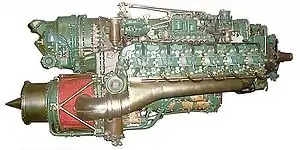 | |
| Napier Nomad II | |
| Type | Turbo-compound aero-engine |
| National origin | United Kingdom |
| Manufacturer | Napier & Son |
| First run | October 1949 |
| Major applications | Avro Lincoln (test bed only) |
Design and development
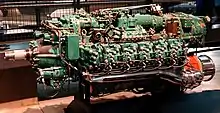

In 1945 the Air Ministry asked for proposals for a new 6,000 hp (4,500 kW) class engine with good fuel economy. Curtiss-Wright was designing an engine of this sort of power known as the turbo-compound engine, but Sir Harry Ricardo, one of Britain's great engine designers, suggested that the most economical combination would be a similar design using a diesel two-stroke in place of the Curtiss's petrol engine.
Before World War II Napier had licensed the Junkers Jumo 204 diesel design to set up production in the UK as the Napier Culverin, but the onset of the war made the Sabre all-important and work on the Culverin was stopped. In response to the Air Ministry's 1945 requirements Napier dusted off this work, combining two enlarged Culverins into an H-block similar to the Sabre, resulting in a massive 75 litre design. Markets for an engine of this size seemed limited, however, so instead they reverted to the original Sabre-like horizontally opposed 12 cylinder design, and the result was the Nomad.
The objective of the design was to produce a civilian power plant with far superior fuel efficiency to the emerging jet engine. Thermal efficiency is given by , where Te is the exhaust temperature in kelvins and Tp is the peak combustion temperature. Jet engines have relatively low-temperature combustion systems which produce a Tp of no more than about 1,000 K, much less than the typical 5,000 K of a reciprocating engine, and so jets have very poor thermal efficiency. The Nomad design focused on replacing the low-temperature combustion chambers of the jet engine with highly efficient Diesel combustion chambers. In practice, it was much too difficult to couple the diesel power output back into the turbine cycle. The maximum practical power of the Nomad was 4,000 hp (3,000 kW), and it was much heavier than a pure jet of the same power. By this time civilian jets such as the Boeing 707 were nearing completion, and the Nomad was never seriously considered by any aircraft manufacturer.
Nomad I
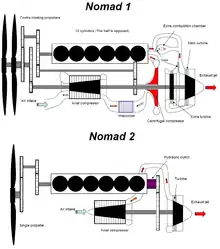
The initial Nomad design (E.125) or Nomad 1 was incredibly complex, almost two engines in one. One was a turbo-supercharged two-stroke diesel, having some resemblance to half of a Napier Sabre's H-24. Mounted below this were the rotating parts of a turboprop engine, based on the Naiad design, the output of which drove the front propeller of a contra-rotating pair. To achieve higher boost, the crankshaft drove a centrifugal supercharger, which also provided the scavenging needed for starting the engine from rest. During take-off additional fuel was injected into the rear turbine stage for more power, and turned off once the aircraft was cruising.[3]
The compressor and turbine assemblies of the Nomad were tested during 1948, and the complete unit was run in October 1949. The prototype was installed in the nose of an Avro Lincoln heavy bomber for testing: it first flew in 1950 and appeared at the Farnborough Air Display on 10 September 1951.[4] In total the Nomad I ran for just over 1,000 hours, and proved to be rather temperamental, but when running properly it could produce 3,000 hp (2,200 kW) and 320 lbf (1.4 kN) thrust. It had a specific fuel consumption (sfc) of 0.36 lb/hp/h (0.22 kg/kW/h).
The prototype Nomad I is on display at the National Museum of Flight at East Fortune Airfield in Scotland.
Nomad II
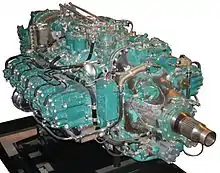
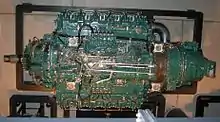
Even before the Nomad I was running, its successor, the Nomad II (E.145) Nomad 6, had already been designed. In this version an extra stage was added to the axial compressor/supercharger, eliminating the separate centrifugal part and the intercooler. The turbine (which also received an additional stage) was now only used to drive the compressor, and feed back any excess power to the main shaft using a Beier variable-ratio gear;[5] the separate propeller from the turbine was deleted, just as the whole of the "afterburner" system with its valves etc. So the system was now like a combination of a mechanical supercharger, and a turbocharger without any need for bypass. The result was smaller and considerably simpler: a single engine driving a single propeller.[6] Overall about 1,000 lb (450 kg) was taken off the weight. The wet liners of the cylinders of the Nomad I were changed for dry liners.[7]
While the Nomad II was undergoing testing, a prototype Avro Shackleton was lent to Napier as a testbed. The engine proved bulky, like the Nomad I before it, and in the meantime several dummy engines were used on the Shackleton for various tests.
A further development, the Nomad Nm.7, of 3,500 shp (2,600 kW) was announced in 1953.[8]
By 1954 interest in the Nomad was waning, and after the only project, the Avro Type 719 Shackleton IV, based on it was cancelled, work on the engine was ended in April 1955, after an expenditure of £5.1 million.
A Nomad II is on display at the Steven F. Udvar-Hazy Center in Virginia.[9]
Applications
- Airspeed Ambassador (planned only)[10]
- Avro Lincoln (test bed only)
- Avro Shackleton (planned only)
- Canadair CP-107 Argus (planned only)
Specifications (Nomad II)
Data from Flight 1954[11]
General characteristics
- Type: Twelve-cylinder, two-stroke valveless diesel engine compounded with three-stage turbine driving both crankshaft and axial compressor.
- Bore: 6.00 in (152 mm)
- Stroke: 7.375 in (187.3 mm)
- Displacement: 2,502 in3 (41.0 L)
- Length: 119 in (3,000 mm)
- Width: 56.25 in (1,429 mm)
- Height: 40 in (1,000 mm)
- Dry weight: 3,580 lb (1,620 kg)
Components
- Valvetrain: Piston ported two-stroke
- Supercharger: Napier Naiad turboshaft and gas generator, maximum boost pressure 89 psi
- Turbocharger: Engine exhaust gases ducted in to Naiad turbine section
- Cooling system: Liquid-cooled
Performance
- Power output: 3,150 hp (2,350 kW) max take-off at 89 psi (610 kPa) boost including 320 lbf residual thrust from the turbine at 2,050 rpm (crankshaft) and 18,200 rpm (turbine)
- Specific power: 1.25 hp/in3 (57 kW/L)
- Compression ratio: 8.1 (cylinder ratio), 31.5:1 (overall pressure ratio)
- Specific fuel consumption: 0.345 lb/(ehp·h) (0.210 kg/(kW·h)) (combined unit) at 11,000 ft and 300 kn
- Power-to-weight ratio: 0.88 hp/lb (1.45 kW/kg)
Turbine section
General characteristics
- Type: Gas generator based on Napier Naiad
- Length:
- Diameter:
- Dry weight:
Components
- Compressor: 12-stage axial flow
- Turbine: 3-stage axial flow
Performance
- Maximum thrust: 320 lbf residual at 18,200 rpm
- Overall pressure ratio: 8.25:1
- Air mass flow: 13.0 lb/s (5.9 kg/s)
- Power-to-weight ratio:
References
- Gunston, Bill (1989). World Encyclopaedia of Aero Engines. Cambridge, England: Patrick Stephens. p. 106. ISBN 1-85260-163-9.
- "Cancelled projects: the list up-dated". Flight: 262. 17 August 1967.
- Lumsden (2003), p. 170.
- Lumsden (2003), p. 172.
- Flight (30 April 1954), p. 549.
- Lumsden (2003), p. 171.
- Flight (30 April 1954), p. 550.
- Flight Nov 1953 p 610
- Steven F. Udvar-Hazy Center - Napier Nomad Retrieved: 7 April 2020
- "Aircraft Intelligence: Great Britain". Flight: 485. 17 April 1953.
- Gunston, Bill (30 April 1954). "Napier Nomad: An engine of outstanding efficiency". Flight: 543–551. Retrieved 18 December 2009.
- Lumsden, Alec (2003). British Piston Engines and their Aircraft. Marlborough, Wiltshire: Airlife Publishing. pp. 170–172. ISBN 1-85310-294-6.CS1 maint: ref=harv (link)
- https://www.thegrowler.org.uk/avroshackleton/the-nomad-proposal.htm – The Nomad Proposal, research by Chris Ashworth – it was amongst the original sources of the article according to the history
External links
| Wikimedia Commons has media related to Napier Nomad. |
- Aircraft Engine Historical Society photo gallery of Napier piston engines
- "Napier Nomad" a 1952 Flight advertisement for the Nomad engine
- "Nomad NNm6" a 1953 Flight article on the Nomad II
- A Napier Nomad 2 mounted in the outboard nacelle of a Shackleton in a 1961 issue of Flight